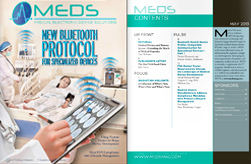Electronics and embedded computer intelligence are certainly not new to the medical device community. One need only think of MRI machines, PET scanners, monitors and the whole host of electronic equipment already in place. Still, there seems to be something new starting to take place and that is associated with the pace of development.
Coming as I do from editing a major trade publication in the OEM embedded systems industry to editing one in the medical device industry, one of the first things I have noticed is that the pace of new product introductions for the medical sector is significantly slower than for the OEM computer market, where new products are constantly flowing in from vendors.
Part of this may have to do with the fact that electronic medical devices are “end user” products in the sense that physicians and medical technicians are those users. However, I also suspect that a large part of the difference involves compliance and certification. This is a completely different world from the one in which companies produce OEM products for building machines for factory automation or transportation systems. And in that arena there is already a certain degree of frustra- tion among suppliers with how long it takes a chip or a board to finally be designed in, proven, and then start generating real revenue once a customer’s design goes into actual production. I can only imagine how that seems when addressing the designers of medical devices and systems.
The FDA is (hopefully) not going to relax its requirements when it comes to compliance for medical devices, even though they are small, mobile and low cost, when they are still vitally impor- tant to a patient’s health and life. It is the OEM supplier segment that is going to have to come to terms with this fact of life. It will take some cultural readjustment.
The embedded computer industry has long followed the PC industry and sometimes the enter- prise industry in terms of technology developments. As some technology like nonvolatile memory or USB or PCI Express became widely accepted in the PC industry, it would find its way into the embedded arena, sometimes with modifications. Then there are always upgrades to these basic technologies—the “dot-number” phenomenon. Then, of course, there is the software. Many em- bedded modules are built so that they can easily take software upgrades over a network and keep functioning. All this is naturally subject to FDA regulation as well. Having the ability to regulate it is another matter.
The fact is that a small handheld device of today may contain more code than an MRI machine of a decade ago. That code is constantly being enhanced and expanded; new processors are coming out to run it faster and more efficiently. A given device may have two or three upgrades available within a year. Reconciling this pace of change and the urge to have the latest technology available, with the compliance requirements of the FDA, is going to represent an ongoing challenge. This even extends to iPhone apps that work with a medical device, and since they do not actually reside in the device, regulating them is going to be even more of a challenge.

